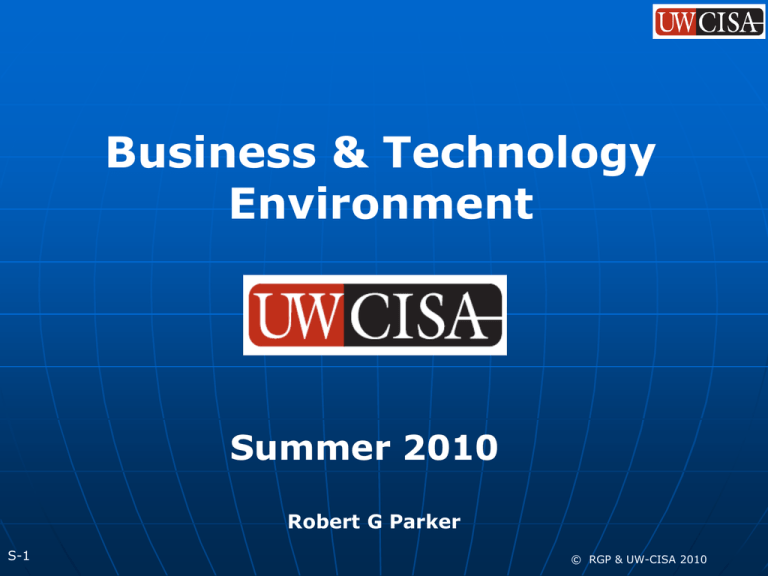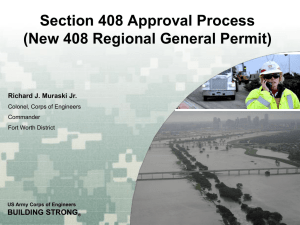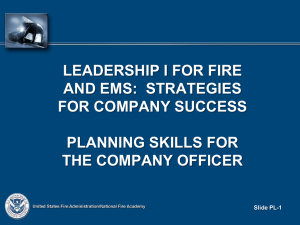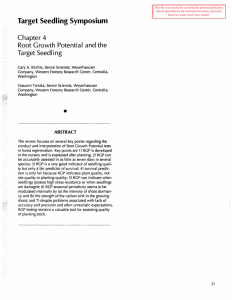Crisis Management
advertisement

Business & Technology Environment Summer 2010 Robert G Parker S-1 © RGP & UW-CISA 2010 Business & Technology Environment Summer 2010 Robert G Parker S-2 © RGP & UW-CISA 2010 Agenda Crisis Management Privacy Social Networks eDiscovery / eEvidence Cloud Computing Parallel Programming S-3 © RGP & UW-CISA 2010 Crisis Management S-4 © RGP & UW-CISA 2010 Crisis Management December 3, 1984 The Incident, Response, and Settlement Initially 3,800 dead. Subsequent deaths have raised the estimates to 25,000 In the early hours of December 3, 1984, methyl isocyanate (MIC) gas leaked from the Union Carbide India Limited (UCIL) plant in Bhopal, India. According to the state government of Madhya Pradesh, approximately 3,800 people died and several thousand other individuals experienced permanent or partial disabilities. Union Carbide’s initial response was denial, quickly followed by aid and assistance The court case: In February 1989, the Supreme Court of India directed a final settlement of all Bhopal litigation in the amount of $470 million. The Government of India, UCC and UCIL accepted the Court’s direction. S-5 Shortly after the gas release, Union Carbide launched an intensive effort to identify the cause. An initial investigation by Union Carbide experts showed that a large volume of water had apparently been introduced into the MIC tank and caused a chemical reaction that forced the chemical release valve to open and allowed the gas to leak. A committee of experts, working on behalf of the Indian government, conducted its own investigation and reached the same conclusion. An independent investigation by the engineering consulting firm Arthur D. Little determined that the water could only have been deliberately introduced into the tank, since safety systems were in place and operational that would have prevented water from entering the tank by accident. © RGP & UW-CISA 2010 Crisis Management In the days, months and years following the disaster, Union Carbide took the following actions to provide continuing aid: • Immediately provided approximately $2 million in aid to the Prime Minister’s Relief Fund; • Immediately and continuously provided medical equipment and supplies; • Sent an international team of medical experts to Bhopal to provide expertise and assistance; • Openly shared all its information on methylisocyanate (MIC) with the Government of India, including all published and unpublished toxicity studies available at the time; • Dispatched a team of technical MIC experts to Bhopal on the day after the tragedy, which carried MIC studies that were widely shared with medical and scientific personnel in Bhopal; • Funded the attendance by Indian medical experts at special meetings on research and treatment for victims; • Provided a $2.2 million grant to Arizona State University to establish a vocational-technical center in Bhopal, which was constructed and opened, but was later closed and leveled by the government; • Offered an initial $10 million to build a hospital in Bhopal; the offer was declined; • Provided an additional $5 million to the Indian Red Cross; • Established an independent charitable trust for a Bhopal hospital and provided initial funding of approximately $20 million, and • Upon the sale of its interest in UCIL, and pursuant to a court order, provided approximately $90 million to the charitable trust for the hospital S-6 © RGP & UW-CISA 2010 Crisis Management Ten days after the decision, UCC and UCIL made full payment of the $470 million to the Indian government. The settlement award was much larger than any previous damage award in India, and was $120 million more than plaintiffs’ lawyers had told U.S. courts was fair. In directing the settlement, the Supreme Court of India reviewed all U.S. and Indian court filings, applicable law and relevant facts, and an assessment of the victims’ needs. In its opinion, the Court said that compensation levels under the settlement were far greater than would normally be payable under Indian law. By November 1990, the Reserve Bank of India reported that the settlement fund, with interest, was approximately twice what was estimated to be needed to compensate the victims. To resolve continuing legal disputes, the Supreme Court of India in 1991 affirmed the settlement; described it as “just, equitable and reasonable,” and dismissed all outstanding petitions seeking review of the settlement. Pursuant to the settlement, the Government of India assumed responsibility for disbursing funds from the settlement. S-7 © RGP & UW-CISA 2010 Crisis Management The Case Drags On An India media report in September 2006 stated that the "registrar in the office of Welfare Commissioner... said all cases of initial compensation claims by victims of the 1984 Bhopal gas tragedy have been cleared… With the clearance of initial compensation claims and revision petitions, no case is pending…" 2010 Concerns are being raised in India over the amount of the settlement ($470 million), given that British Petroleum have already set aside a $ 20 Billion fund for clean-up. Only 11 lives were lost, all oil rig workers, compared with 3,800 civilians in Bhopal, and climbing towards 25,000. S-8 © RGP & UW-CISA 2010 Crisis Management 2010 Seven former senior employees of Union carbide convicted for their role in the 1984 leak Sentenced to two year terms in prison Victims protest the light sentences “More than 25 years later thousands of children are born with brain damage, missing palates and twisted limbs because of their parents exposure to the gas Source-Globe & Mail June 8, 2010 S-9 © RGP & UW-CISA 2010 Crisis Management BP oil spill costs soar above $3B Agence France-Presse First Posted 06:31:00 07/06/2010 Filed Under: Environmental pollution, Disasters & Accidents, Oil & Gas - Upstream activities NEW ORLEANS—BP's costs over the Gulf of Mexico oil spill soared Monday above $3 billion, while a giant Taiwanese ship provided hope of revolutionizing on-sea skimming operations. "The cost of the response to date amounts to approximately $3.12 billion, including the cost of the spill response, containment, relief well drilling, grants to the Gulf states, claims paid, and federal costs," BP said. The latest estimate is far higher than the $2.65 billion given by the energy firm one week ago. BP's share price has collapsed more than 50 percent since the Deepwater Horizon oil rig it leased sank on April 22, two days after a blast that killed 11 workers. After intense pressure from President Barack Obama over the worst ever US environmental disaster, BP agreed last month to suspend its shareholder dividend and create a $20-billion fund for costs arising from the spill. BP is also selling non-core assets to raise $10 billion, while international ratings agencies have downgraded the company's credit worthiness. S-10 Source: Inquirer.net – July 6, 2010 © RGP & UW-CISA 2010 Crisis Management What Happened in the 25 Years In Between Bhopal and BP? Chicago Tylenol murders The Chicago Tylenol murders occurred when seven people died after taking pain-relief capsules that had been poisoned. The Tylenol poisonings, codenamed TYMURS by the FBI, took place in the autumn of 1982 in the Chicago area of the United States. These poisonings involved Extra-Strength Tylenol medicine capsules which had been laced with potassium cyanide.[1] The incident led to reforms in the packaging of over-the-counter substances and to federal anti-tampering laws. The case remains unsolved and no suspects have been charged. A $100,000 reward, offered by Johnson & Johnson for the capture and conviction of the "Tylenol Killer," has never been claimed. Aftermath The media gave Johnson & Johnson much positive coverage for its handling of the crisis; for example, an article in the Washington Post said, "Johnson & Johnson has effectively demonstrated how a major business ought to handle a disaster." S-11 © RGP & UW-CISA 2010 Crisis Management Aftermath The article further stated that "this is no Three Mile Island accident in which the company's response did more damage than the original incident," and applauded the company for being honest with the public. In addition to issuing the recall, Johnson & Johnson established relations with the Chicago Police, the FBI, and the Food and Drug Administration. This way the company could have a part in searching for the person who laced the Tylenol capsules and they could help prevent further tamperings.[8] While at the time of the scare the market share of Tylenol collapsed from 35% to 8%, it rebounded in less than a year, a move credited to J&J's prompt and aggressive reaction. In November, it reintroduced capsules but in a new, triple-sealed package, coupled with heavy price promotions and within several years, Tylenol had become the most popular over-the-counter analgesic in the US. S-12 © RGP & UW-CISA 2010 Crisis Management Tylenol became the new high-water mark in crisis management There followed a series of events that created crisis management procedures and best practices: Pepsi – Followed Tylenol’s example - grocery store caught customer tampering with soda bottles Ford – Initially indicated that they made the cars, not the tires, but quickly offered to replace the tires on any of the SUVs susceptible to roll-overs with any tires the customer wanted. (Consider Ford’s ranking amongst the Detroit 3 today!) Toyota – Floor mats, accelerator, congressional hearings and denials. There were other examples, some followed best practices and others didn’t. The marketplace remembers. S-13 © RGP & UW-CISA 2010 Crisis Management Planning and Preparation Incident Identification Incident Stabilization and Containment Incident Remediation Incident Recovery Event Monitoring and Reporting S-14 Incident Communication Six Steps of Event/Crisis Management © RGP & UW-CISA 2010 Crisis Management What Happened With British Petroleum? Planning and Preparation Limited emergency equipment on hand Had to design, build and test potential solutions Delays measured in weeks and months In effective communications plans Denial: It wasn’t our drilling platform we hired it complete with crew, etc It is only a small leak 5,000 bbls per day S-15 Source USA Today – June 6, 2010 © RGP & UW-CISA 2010 Crisis Management Incident Identification They knew they has a potential disaster Their identification of the event was based response on poor and unrealistically low estimated They failed to understand the enormity and complexity of the challenge in situations where the blow-out protector failed in deep water S-16 © RGP & UW-CISA 2010 Crisis Management What Happened With British Petroleum? Incident Stabilization and Containment Successive failures to cap the well Inability to stop the flow Inability to capture leaking oil at the source Employment of dispersal rather than capture – Likely exacerbated the situation The situation was neither stabilized or contained S-17 © RGP & UW-CISA 2010 Crisis Management What Happened With British Petroleum? Incident Remediation Remediation deals with repairing or changing the cause in order to eliminate the cause of the “event” Criticism of the efforts of BP BP failed to achieve any of their goals in the estimated times Initial response was to break the oil up A solution is still not in sight; response consists of larger clean up ships S-18 © RGP & UW-CISA 2010 Crisis Management What Happened With British Petroleum? Incident Recovery They based response on poor and unrealistically low estimated Until the cause of the incident is remedied the recovery (returning to pre event processes) tasks cannot begin Every critical date has been missed S-19 © RGP & UW-CISA 2010 Crisis Management What Happened With British Petroleum? Event Monitoring and Reporting Reporting has been relentless but the reports do not shed light on the solution, simply the problems and failures Moral High-ground S-20 © RGP & UW-CISA 2010 Crisis Management What Happened With British Petroleum? Crisis Communications Internal – key incident response teams and all employees External – clear, do not mislead, single authoritative source, targeted Legal/Regulatory – meet legal requirements, meet public expectations Transparency – sufficient information to explain the situation and its impact on businesses & individuals, particularly personal information Best Practices – additional items, PI breaches = credit monitoring Pre-scripted Messages – respond in a reasonable period of time Monitor Promised Activities – progress & effective action S-21 © RGP & UW-CISA 2010 Crisis Management What Happened With British Petroleum? Crisis Communications April 20, 2010 – July 11, 2010 = 82 days Don’t go off script – “I want my life back” S-22 © RGP & UW-CISA 2010 Crisis Management Issues Few business have enterprise risk management programs Few business have comprehensive, enterprise-wide, Business Continuity Plans IT Disaster Recovery Plans are, to varying degrees, being addressed Crisis communications require attention S-23 Security Disaster Recovery / Business Continuity Katrina highlights DR need By: Warren Lee IT World Canada (16 Sep 2005) Hurricane Katrina made every IT organization question the viability of its disaster recovery (DR) plan. A natural disaster, a major accident or a terrorist act in the headlines forces us to think about survival. Could your facility, or your business, take a hit like that and survive? At such times, many businesses resolve to ensure that their data assets are protected. Yet in the years since 9/11, the 2003 blackout, the Quebec ice storm and Hurricane Andrew, there has been little real change in the way businesses manage these sorts of risks. While spending on disaster recovery and business continuity (BC) activities has risen, such increases are gradual and do not reflect the attention spikes that follow disasters. A year after the 2003 blackout that left a large swath of North America’s industrial heartland without electricity for several days, the Leger Group surveyed 300 Ontario business leaders about their business continuity plans. They found that only 30 per cent have a full-blown business continuity plan, while another 32 per cent claim to have an informal plan; 28 per cent had no plan at all. © RGP & UW-CISA 2010 Crisis Management Opportunities Increased guidance and direction on incident management and crisis communications Service offerings including period reviews/assessments of an entity’s crisis preparedness Increased focus on enterprise risk management from a shareholder/stakeholder perspective Increased attention to business continuity issues, including supply chain and reliance on others We have to do a Better Job of Enterprise Risk Management S-24 © RGP & UW-CISA 2010










